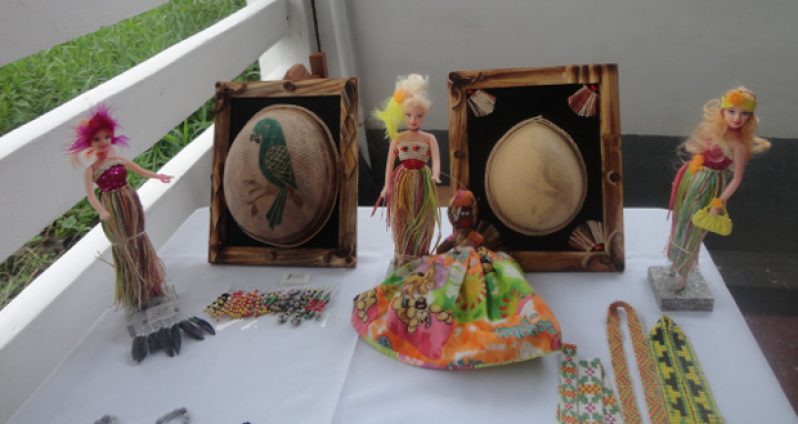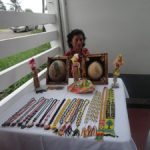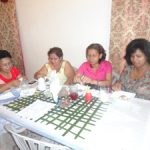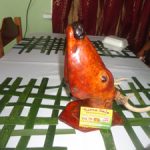AN aromatic wild meat pepperpot or a juicy black water fish sauce, served with crisp fresh cassava bread washed down with a cup of sweet sage tea and followed by a dessert of homemade wine and fresh fruit would have previously been a hard meal to source in the capital; but that was before the advent of the recently launched Tuma Sálâ Restaurant and Craft Shop, located at 37 Middleton Street, Campbeville, Georgetown.
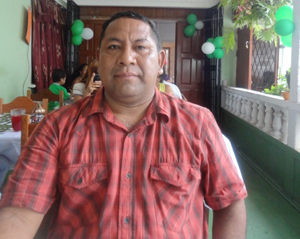
However, entrepreneur Michael Patterson, Tourism Manager at Roraima Airways, has thrown his cap into the proverbial ring, and has made the bold move of offering authentic Amerindian cuisine for the first time in such variety in this part of the country.
Menu choices include the perennial Pepperpot (Guyana’s national dish and a Christmas Day staple), but with more indigenous and exotic choices of meat, such as deer, bush cow (tapir) and labba (a step away from beef and pork) served with cassava bread, farine, and tea or wine.
The Tuma pot choices include the same meats as the pepperpot choices, along with a selection of delicious hymara or lukanani fish, which is more tender, juicier and stronger than popular choices such as trout or snapper.
Side dishes include richly indulgent choices, such as seasoned farine and boiled and fried provisions; or very healthy and nutritious choices such as calalloo or eddo soup, sweet potato salad, fruit salad and garden salad.
In keeping with the restaurant’s theme don’t expect beer, soda or canned and bottled fruit juices. Instead, wash down your meal with a refreshing glass of homemade fruit juice; chilled coconut water; favourite indigenous wines, Paiwari and Fly; or a nice cup of hot sweet sage, sweet broom or capadulla tea, if you prefer.
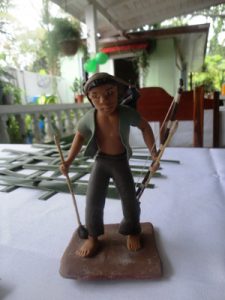
In keeping with the Amerindian theme, the restaurant’s décor features charming Amerindian handicraft on every table, and visitors can go away with a beautiful piece of Amerindian jewellery or other souvenirs on sale at the craft shop up front.
Patterson said the idea for this venture has been around for about 20 years. He has been in the hospitality industry for decades, and is currently working for Roraima Airways, having previously worked with Iwokrama and individually, starting many of the tourism services of Santa Mission, from where he originated.
Patterson says: “At this level, we would like to promote Guyana. The whole idea is to provide a service of authentic Amerindian cuisine, targeting the entire Guyanese population initially and then the non-Guyanese who visit here. I want them to have an experience of enjoying the culture — especially the Amerindian culture — of the Guyanese people. So while we are promoting our culture, we want to demonstrate that we can have economic returns from it.”

Patterson noted that Amerindian food had previously been presented on occasions such as the yearly exhibitions at the Sophia Exhibition Site, where people come together — small businesses and ladies with their craft; but the opportunity to present Amerindian food on a continuous basis has been lacking, and people desiring Amerindian food outside of those occasions have to wait until the following year.
Tuma Sala team members include head Chef Angela Williams, a seasoned cook and a person offers this type of food every year at the exhibition centre. The restaurant’s staff comprise youths with personality, who enjoy what they are doing. They responded to the advertisement on Facebook, and will have on-the-job training, Patterson said.
He said Pepperpot can be done in a variety of ways, and there is the Cakadura pot or the Tuma sauce — a by-product of cassareep manufacturing.
“While you’re boiling (the cassava), you take off the froth at the top and you take it and make it into this sauce we call Cakadura sauce,” Patterson explained.
Wanting to know whether the food was uniquely Guyanese or was influenced by Brazilian cuisine, I asked Patterson to clarify; and he noted that Amerindians are unique to Guyana, with nine distinct tribes. Some of the tribes, such as the Makushi, live in areas close to Brazil. The Warraus live in areas near to Venezuela. He noted that there are certain commonalities between the tribes in food and beverage, even though what one tribe, such as the Arawaks call paiwari, another, such as the Macushi may call it parakari; but it’s basically the same product.
While Patterson might compromise with customising some food options to suit a client, there are some things he just won’t do-one of which is serving chicken. “You can go somewhere else and get chicken,” he said. “But something like a Guyanese food, like a (dish of) boiled and fried provision, you can have that. A corn soup you can have. A crab soup or some form of the soup you can have. We can cater for a vegetarian by preparing a nice vegetarian soup, sweet potato salad or a garden salad.
“So we can have these foods that are not necessarily authentic Amerindian foods (even though they) utilise some of the same ingredients and blend in well,” he said. But make no mistake: one cannot come to this restaurant and get drunk. “Only indigenous wines are available, and only in small quantities, at least on the premises,” Patterson disclosed
He said he doesn’t know what will happen ‘down the line’ but the restaurant does not want to be “linked with that”. A lot of the miners may not want pepperpot made with cadakura-for them the restaurant can do stir-fried cutters – which they can take away.
Background
Most of Patterson’s professional background comes from Iwokrama, an international conservation project that has been around for quite a while. He was among the first batch of rangers undergoing training in 1996 and 1999.
“We were like the guinea pigs for that project; we had the best trainers, who would come in from different countries. We also imparted our knowledge. We were doing training and at the same time working. Most of my background is around natural resource management, and is based around the foundation of Iwokrama,” he said.
After he left Iwokrama, he went back into Santa Mission and was involved in Santa Mission development with a focus on natural resource management, in particular lumbering.
“To qualify to work at Iwokrama you had to send a letter about why they should hire you. And we had this situation where people were coming in to the village to raid the village and we didn’t have trained people. So I described the scenario,” he said, noting that the mainstay of the community is logging, handicraft and tourism.
When Patterson went back to Santa Mission, he started a small business, but it proved not to be enough to sustain his growing family, so he eventually moved his family from the community. His wife, who was at the time a health care worker, is currently a Registered Nurse.
He returned to Iwokrama, this time as a Project Manager to manage an aquarium project on a two-year lease and afterwards worked as a Logistics Coordinator. He noted that it was a challenge to be away from his family. He wanted to be closer to his family so he came back to Georgetown in 2007. He sent his impressive résumé around, spanning a web of ministries and private sector entities, and Roraima Holdings responded.
He began working there as a tour superintendent and worked his way up to manager in only a year. He says: “Roraima is a fast paced company doing several things at one time. You have to be able to handle pressure, to make decisions and to be accountable for those decisions. So being there gives you the experience of being in an organisation that provides service with reliable consistency. Consistency is one of the keywords; you have to do well all the time.”
He added: “So I know about the tourism industry in Guyana. I’ve been a member of the tourism and hospitality industry, familiar with the regulations of resorts and tour guides, and I have the experience of going from destination to destination. So if I’m selling you a tour, I know from personal knowledge of having been there myself.”
Written By Michelle Gonsalves




.png)


